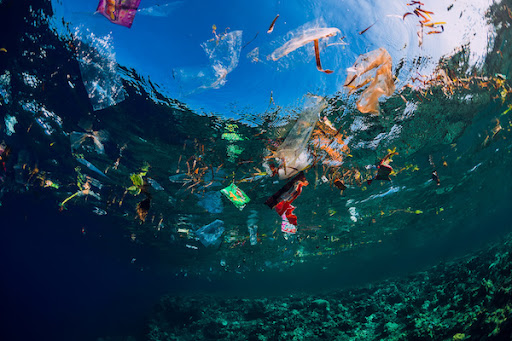

Did you know that the amount of plastic packaging discarded in one year is enough to circle the globe four times?
From food packaging to carrier bags, plastic is well and truly everywhere — and this is bad news for our planet. While some plastics can be recycled, most end up in landfill sites or, worse, in our oceans. In fact, over 80% of plastic in the ocean right now originates on land from sources such as industrial and commercial packaging.
Read on to find out why the team at BISON stay away from plastic packaging and get some motivation to refine your own packaging policies while you’re at it!
As mentioned, we avoid plastic packaging where possible due to it constantly being dumped in landfills across the world.
It is estimated that 12 billion tonnes of plastic waste will be in landfill or the natural environment by 2050, and plastic packaging makes up a large proportion of this statistic. With the average plastic bottle taking over 450 years to biodegrade completely, we must ask ourselves: is it worth it? When taking into account the fact that many plastics leak pollutants into the soil and water supply when breaking down, it really isn’t.
Paper and cardboard products, on the other hand, can be recycled easily or take just 2- 6 weeks to break down if accidentally sent to landfill and are a much more planet-conscious option as a result.
You may well have heard the tirades against plastic straws on account of saving the turtles, but plastic packaging is another topic altogether — and much, much more harmful. It is now estimated that in every square mile of sea, there are 46,000 pieces of plastic, plenty of which will have come from irresponsible packaging recycling methods.
As The Guardian claims, “Plastic bags and flexible packaging are the deadliest plastic items in the ocean, killing wildlife including whales, dolphins, turtles and seabirds around the globe, according to a review of hundreds of scientific articles.” Once plastic enters the ocean, it is almost impossible to remove it since it is quickly broken down by the dual action of the waves and wind into microplastics (plastic particles less than 5mm in length). These particles then form larger masses such as the Great Pacific Garbage Patch (which now weighs 80,000 tonnes).
According to Wrap.org, the production, use, and disposal of plastic packaging contribute over 1.8 billion tonnes of carbon emissions each year. As the world produces 141 million tonnes of plastic packaging each year, it is easy to see why the emissions levels are so high.
But let’s break it down further. Just how exactly does plastic contribute to climate change? Well, almost every type of plastic contains materials such as Propylene and Ethylene that are made from fossil fuels (oil and gas).
In order to extract these materials to make plastic, fossil fuels are burnt, releasing harmful greenhouse gases. According to WWF Australia, 4% of the world’s annual petroleum is burnt in this process.
Plastic packaging, in particular, is a problem for the UK and is a primary focus for waste-reduction initiatives. Nearly 70% of the UK’s plastic waste actually comes from packaging, illustrating perfectly the need to cut down on this method of packing products.
One of the main issues with plastic packaging is the uncertainty when it comes to recyclability. Not many people know whether they should recycle packaging and it isn’t always made clear — even on the packaging of household names. Even when it is clear, only a third of consumer packaging is recycled, according to the Recoup Household Plastics Collection Survey.
The two main culprits used in plastic packaging are Polypropylene and Polystyrene — both of which are not currently recycled.
Finally, the main reason why we avoid plastic packaging where possible is that we have invested in sustainable, responsible alternatives.
Since 2020, we’ve had what we like to call “a major, planet-first overhaul”. Included in this was a decision to review all of our products, services, and packaging to ensure that zero waste goes to landfill.
On top of this, we reduced the amount of plastic in our packaging (and for one-time use) by 95%, relying instead on more sustainable, plant-based packaging alternatives. These options are also 100% biodegradable and ISO 14001 certified.
What’s more, it has been statistically proven that consumers don’t want to use plastic packaging either! According to a recent study by Forbes, 88% of UK and US consumers actively want brands to help them be more environmentally friendly in their daily lives. It is no secret that brands that align themselves with eco-friendly principles are favoured by consumers.
If you’d like to find out more about our planet-first mission, head over to our BISON Planet page or contact us today.
If you would like to keep updated with all news and developments, please subscribe to our mailing list.